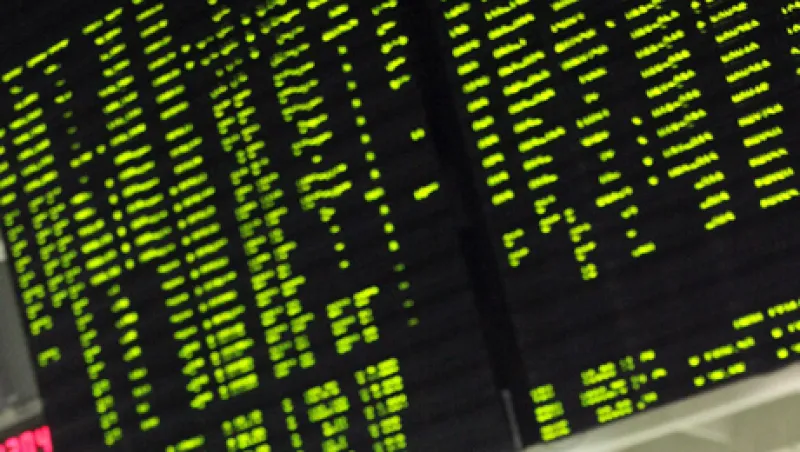Exchange Traded Funds have emerged as the perfect investment vehicle for uncertain times. The funds include baskets of assets such as stocks and bonds, or derivatives that reflect their value. Unlike mutual funds, they can be traded all day long, allowing investors to get in and out of markets in an instant. It is almost as if someone designed them with the risk-on, risk-off era in mind.
As the ETF sector has grown in size and power, a debate over their effect on the markets has emerged. Global ETF assets are growing nearly 40 percent a year, and have reached $1.4 billion. While ETFs are still just 10 percent the size of the conventional mutual fund industry, they punch far above their weight. accounting for one third of the value of all U.S. equity trades and 10 percent of the number of actual trades.
It should come as no surprise that the industry is drawing more scrutiny. Two researchers at the non-profit Ewing Marion Kauffman Foundation in Kansas City -- chief investment officer Harold Bradley and vice president of research and policy Robert Litan -- warned in white paper and in prepared Senate testimony that ETFs were a source of volatility and systemic financial risk.
“ETFs are radically changing the markets, to the point where they, and not the trading of the underlying securities, are effectively setting the prices of stocks of smaller capitalization companies, or the potential new growth companies of the future,” Bradley says.
“In the process, ETFs that once were an important low-cost way for investors to assemble diversified stock holdings are now undermining the traditional price discovery role of exchanges, and in turn, discouraging new companies from wanting to be listed on U.S. exchanges,” Litan argued.
The ETF industry has vigorously rejected the argument.
Wharton professor Jeremy Siegel, an advisor to ETF sponsor Wisdom Tree, says ETFs aren’t causing volatility, but merely reflecting it. “The volatility we see in today’s markets is not linked to ETFs,” Siegel asserted in an interview, adding, “I don’t think ETFs raise the level of systemic risk at all. I don’t understand the mechanism.” He notes that the size of the ETF industry is still very small compared to mutual funds.
If nothing else, the debate has focused investor attention on the fact that ETFs — which include a wide array of asset classes and strategies — are a diverse and complex set of vehicles. ETF risk levels can vary greatly, especially when due to the use of leverage or derivatives.
ETFs can provide investors with flexibility and speed at relatively low cost. But some observers say there may be too much of a good thing. “There are 1,000 ETFs and most investors probably can accomplish their goals with 10. What do you do with the other 990?” asks Mark Zurack, a professor of finance and economics at Columbia Business School and a retired partner at Goldman Sachs, where he started the equity derivatives research group. “In some cases, ETFs may not be adding value, but the basic concept has enormous value. It doesn’t mean there isn’t some fire, but you have to dig into the details,” he said.
Potential concern focuses on how ETFs are constructed. Some ETFs own the actual assets in its portfolio, while others use a “synthetic” approach to replicate an index, using swaps or other derivatives. And the leverage that is inherent in a synthetic approach can lead to more volatility.
“When you look at markets that have displayed high volatility on a given day, clearly ETFs have been even more volatile,” said Ken Leon lead ETF analyst at S&P Capital IQ.
Some observers say leveraged funds are more like swaps than funds and should be marketed as such. But in Europe, unlike the U.S., they are allowed to be marketed as funds.
“They really are leveraged swaps,” says Zurack. “They are not the same as ETFs in the U.S.”
Sponsors in the U.S. include iShares, State Street and Blackrock. State Street markets the world’s second largest ETF, the GLD fund -- backed entirely with actual gold in a vault in London.
Some assets, particularly in the fixed income market, can be more difficult to find than gold. In those cases, it is easier and often cheaper to construct an ETF with futures or other derivatives.
In addition, synthetic portfolios can introduce the risk of tracking error, in which the derivatives in the portfolio are poorly correlated with the price of the underlying asset. Synthetics for highly liquid indexes such as the Euro Stoxx 600 should have a high level of correlation, but the correlation between an ETF and a less-liquid index may be lower, according to Leon.
Leverage can goose performance in either direction. “Bull” funds are designed to produce gains of two or three times the upward move in the price of the underlying asset. “Bear” funds, also called “inverse leveraged funds,” are designed to produce a gain equal to two or three times the decline in the price of the underlying asset.
In addition, the market-beating potential of leveraged ETFs come with a risk beyond greater volatility. For example, the returns of inverse leveraged ETFs are designed to go down over time. They are engineered for short-term use, as brief as one day, according to Morninstar. Not all investors understand that purpose. “It is sort of like a put. You don’t have a sudden downside, but the price you pay for that is a deteriorating asset,” Siegel said.
In Europe, if not the U.S., ETF investors need to heed the old “caveat emptor” saw.






